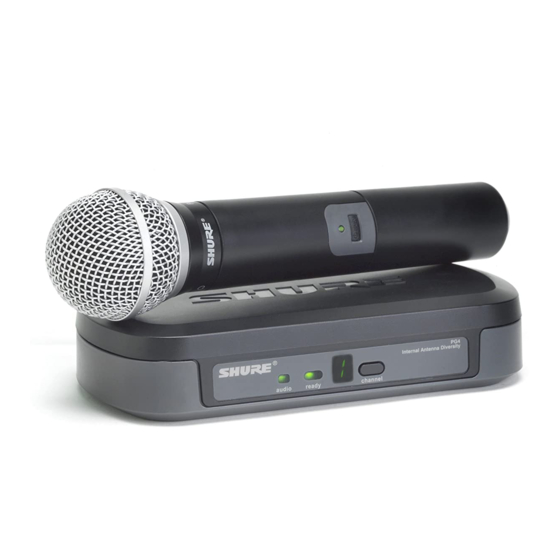
Shure Performance Gear Manual
Hide thumbs
Also See for Performance Gear:
- User manual (31 pages) ,
- Manual (6 pages) ,
- User manual (6 pages)
Table of Contents
Advertisement
Quick Links
C
ongratulations on
purchasing your Shure
Performance Gear Wireless
system. Shure professional
audio products deliver
legendary sound quality,
stage-proven durability and
©2006, Shure Incorporated
27EN8865 (Rev. 3)
hassle-free setup for worry-free
performance.
Performance Gear Wireless
systems are available in a
variety of configurations for
handheld, guitar, headset, and
presentation
applications.
Printed in U.S.A.
Advertisement
Table of Contents

Summary of Contents for Shure Performance Gear
- Page 1 Shure Performance Gear Wireless Performance Gear Wireless systems are available in a system. Shure professional variety of configurations for audio products deliver handheld, guitar, headset, and legendary sound quality, presentation applications.
-
Page 2: System Components
System Components PS20 Power Supply PG88 Dual Wireless Receiver PG4 Wireless Receiver Bodypack Transmitter PG2 Handheld Transmitter PG185 Lavalier Mic y-free PG30 Headworn Mic U.S.A. - Page 3 If you Startup battery cover o Follow these simple steps to check for interference and to set your receiver and transmitter to the same channel Turn OFF the microphone Turn O or bodypack. bodypa pressin If left on, it will create a false busy indicator.
- Page 4 If you haven’t installed the battery, do it now and leave the cover off. e and to nnel Turn ON the handheld or bodypack transmitter by pressing the power button. The channel display should illuminate. It turns off after ten seconds to conserve battery.
-
Page 5: Changing Channels
Features Lock Lock sy Busy Indicator To lock When selecting channels, and ho a flashing dash indicates Power/ interference from television broadcasts, electronic devices To unlo or other wireless systems. Power/ If this occurs, change the channel. Acce Changing Channels Multiple gain s To change gain Press and hold the channel... - Page 6 Locking and Unlocking Transmitter Controls Lock system controls to prevent accidental muting. To lock controls: Turn transmitter off. Remove Battery Cover. Press and hold Channel Button. Press and release Power/Mute button. Power/Mute LED will flash red and green. To unlock controls: Press and hold Power/Mute button down until Power/Mute LED flashes red and green.
-
Page 7: Multiple System Setup
Trou Multiple System Setup To set up multiple systems, repeat the previous steps for each transmitter and Issue receiver pair. Once transmitters have been set, leave them on. Be sure to set No sound each transmitter and receiver pair to a different channel. For information about faint sound frequencies and compatibility, refer to channel guide. -
Page 8: Troubleshooting
Troubleshooting itter and Issue LED Status Solution re to set No sound or Transmitter Power/ • Perform transmitter setup. on about faint sound Mute LED on, • Verify all sound system connections. receiver LEDs on • Adjust transmitter gain. Receiver Channel •... -
Page 9: Replacement Parts
System Components Tech All Systems System PG4 or PG88 Receiver Working Rang Internal Diversity Antenna System One 9 volt battery AC Power supply User guide Audio Channe Vocalist System Total Harmoni Microphone Head PG2 handheld transmitter Microphone clip Dynamic Rang Operating Tem Instrument System Range... -
Page 10: Technical Specifications
Technical Specifications System Working Range 75m (250 ft.) Note: actual range depends on RF signal absorption, reflection, and interference. Audio Channel Response Minimum: 45 Hz. Maximum: 15 kHz (overall system channel depends on microphone element). Total Harmonic Distortion 0.5%, typical Ref. -
Page 11: Regulatory Information
Technical Specifications cont’d Changes or PG4 and PG88 Receiver could void t to the follow device mus Output Impedance XLR connector: 200 Ω 1/4 inch connector: 1kΩ operation o Audio Output Level Ref. XLR connector (into 100K Ω load): –19 dBV, typical Pate +/–... - Page 12 Caution Changes or modifications not expressly approved by Shure Incorporated for compliance could void the user’s authority to operate the equipment. Operation of this device is subject to the following two conditions: (1) this device may not cause interference, and (2) this device must accept any interference, including interference that may cause undesired operation of the device.








